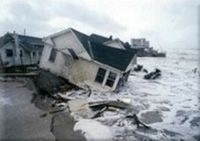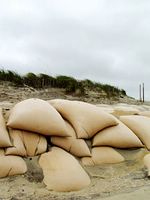The Outer Banks
 I wrote first about erosion, development, and the Outer Banks here, and then here. This post concludes my beach rant.
I wrote first about erosion, development, and the Outer Banks here, and then here. This post concludes my beach rant.Orrin Pilkey, professor emeritus at Duke University's Nicholas School of the Environment and Earth Sciences, has for decades been the Cassandra and Lorax of the Outer Banks. He warns us of simple things:
- The Barrier Islands are migrating inland. Storms rip sand from the east (ocean side) and dump it on the west (bay side). Vegetation is supposed to stabilize the newly deposited bay-side sand, providing a base for the island to shift onto.
- Preferring the beach side, we build permanent structures where they don't belong. We flout the ocean. Everything we do to stave off the inland migration, however, will eventually destroy the beach and/or fail.
- Hardening the shoreline - building jetties and seawalls, dumping rocks and sandbags - robs sand from adjacent areas. "Seawalls protect buildings but destroy beaches."
- Beach replenishment (dumping sand) degrades the coastal ecosystem by killing every living thing in the sand.
- Hardening the shoreline - building jetties and seawalls, dumping rocks and sandbags - robs sand from adjacent areas. "Seawalls protect buildings but destroy beaches."
- The ocean will win in the end.

| From Shoring Up N. Carolina Islands: A Losing Battle? by John Roach: Humans made their first significant mark on the Outer Banks in the 1930s when the Works Progress Administration and the Civilian Conservation Corps built a dune ridge along the Outer Banks to help stabilize the islands. Since then, the dune has been continuously maintained. Whenever storms push the dune sand over the island, trying to keep the Outer Banks above the rising sea level and making what coastal scientists call a platform for the islands to migrate onto, crews are dispatched to push the sand back and rebuild the dune. The dune was first rebuilt after every storm by the National Park Service until the 1970s. When the park service called it quits, the North Carolina Department of Transportation moved in to protect U.S. Highway 12, which was constructed after World War II, according to Rice. |
 Pilkey: "U.S. Highway 12 has been allowed to all but stop nature's course in the Outer Banks so that thousands of people can access their million-dollar homes inside the Cape Hatteras National Seashore."
Pilkey: "U.S. Highway 12 has been allowed to all but stop nature's course in the Outer Banks so that thousands of people can access their million-dollar homes inside the Cape Hatteras National Seashore.""We know that roads that run perpendicular to the shoreline or go right up to the beach act as conduits for storm surge, so we shouldn't build or rebuild them," Pilkey's colleague Andrew Coburn said. "Yet you find them in nearly every oceanfront community."
| From Fighting the Tide: Cape Hatteras Lighthouse Retreats from Rising Sea by Andrew Shepard, Associate Director, National Undersea Research Center at UNCW [Written as the decision was being made to move the Hatteras Lighthouse] According to a National Research Council study on the lighthouse’s predicament, if present trends continue, sea-level will rise up to 0.5 feet and the shoreline in front of the lighthouse will retreat 400 feet by the year 2018. By the year 2088, the retreat may reach over a half a mile inland. Evidence of past barrier islands can be found hundred of miles inland and well offshore of the Carolinas. Before human’s developed the coast, it was like a tree falling in the woods-- nature did its thing and no one noticed the quiet movement of the beaches. Things are different now. By 2018, well over half the nation’s population will live within five miles of a beach. Houses and hotels now extend from end to end on most of North Carolina’s barrier islands. |
 Stanley Riggs, coastal geologist at East Carolina University in Greenville: "The minute we put something out there we want to protect it. All of a sudden we are at war with the ocean." Retreat is no longer an option.
Stanley Riggs, coastal geologist at East Carolina University in Greenville: "The minute we put something out there we want to protect it. All of a sudden we are at war with the ocean." Retreat is no longer an option. North of Buxton there's a stretch of Route 12 where the dune is an arms-length from the cars. In stormy weather, time your trip to reach that area at low tide: at high tide, the ocean is over the road. After bad storms the road is completely buried in sand. Traffic stops while bulldozers pushed it back off the road.
Pilkey: "The sea level is rising now, which provides a crooked shoreline. Nature abhors a crooked shoreline, so nature is trying to straighten the shoreline out."
 The ocean wants the sand to be in the road. The Army Corps of Engineers and the Highway Department want it back on the dune. The dune's been washed out so often it has no sea oats. It's a sandbox sierra built by real Tonka Toys. The ocean, just yards away, licks at it and laps over the top.
The ocean wants the sand to be in the road. The Army Corps of Engineers and the Highway Department want it back on the dune. The dune's been washed out so often it has no sea oats. It's a sandbox sierra built by real Tonka Toys. The ocean, just yards away, licks at it and laps over the top. My son points out that inlanders, who don't have access to the ocean lifestyle, foot the tax bill for endless projects that allow beachfront property owners and developers, at least for now, to recoup and grow their investments.
 The state subsidizes beach development by building and maintaining roads, bridges, sewers; by dredging inlets and building jetties; by providing disaster assistance after storms. Once structures have been built, even if everyone knows they shouldn't be there, resources are massively deployed to protect them. The government even offers flood insurance, so there's little risk.
The state subsidizes beach development by building and maintaining roads, bridges, sewers; by dredging inlets and building jetties; by providing disaster assistance after storms. Once structures have been built, even if everyone knows they shouldn't be there, resources are massively deployed to protect them. The government even offers flood insurance, so there's little risk. Pilkey made his pitch concisely in this article:
The price society is paying for beachfront development will only go up, and each storm will make this point again. But there are some things we can do:
- End the sympathy for beachfront-property owners and recognize foolish acts for what they are.
- Encourage the removal of destroyed and threatened buildings and replace them with natural dunes.
- Stop charging federal and state taxpayers for replenishing beaches.
 Here are some related reads:
Here are some related reads:- Renourish beaches or lose them
- So they build seawalls (has pictures of the effects of "hardening" the beaches)
- Nature Tries to Shift Outer Banks but Man Keeps Shoveling It Back
- News Tip: Hurricanes Bring Benefits to Barrier Islands and Beaches, Even as They Devastate Communities Located There
Technorati Tags: Ocean, Beach, North Carolina, Development, Environment, Folly












4 Comments:
This is an outstanding series of posts on a subject that's near and dear to my heart. I can't wait to explore your blog more, and what a nice bonus to find a fellow Tar Heel!
I meant to comment on this- the Feds and State need to get out of the Ins biz.
If you have a policy now, it can pay off just once. After that, your on your own.
Ahhh, I live on an island in the west where out big problem is bluff erosion (as opposed to sand "encroachment"). We also have nearby areas that suffer from flooding on a fairly regular basis. I don't have much pity for the people that choose to live in these areas, then complain when things go bad. And as a geologist, I'm totally fascinated by the natural processes that occur.
I love your blog, I'll have to visit more often.
Cheers!
I live on he Island and own houses on the ocean front as an owner i am not allowed to use all means neccisary to protect my houses Such as building retaining walls and the beach front areas pay more taxes than others do who arent in beach impacted areas.
Post a Comment
<< Home